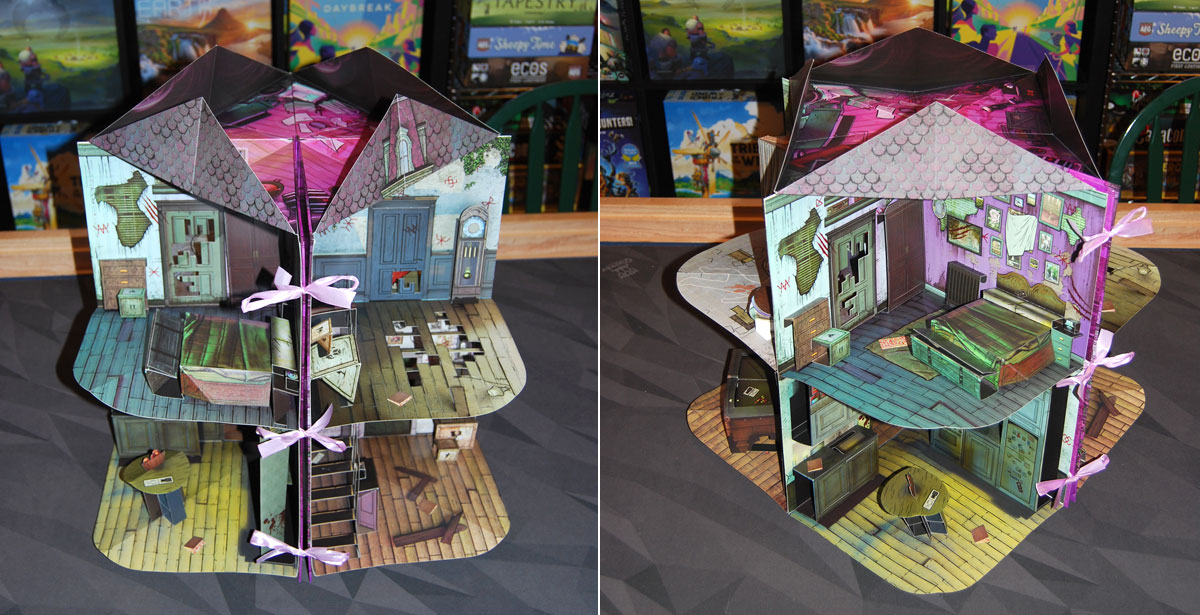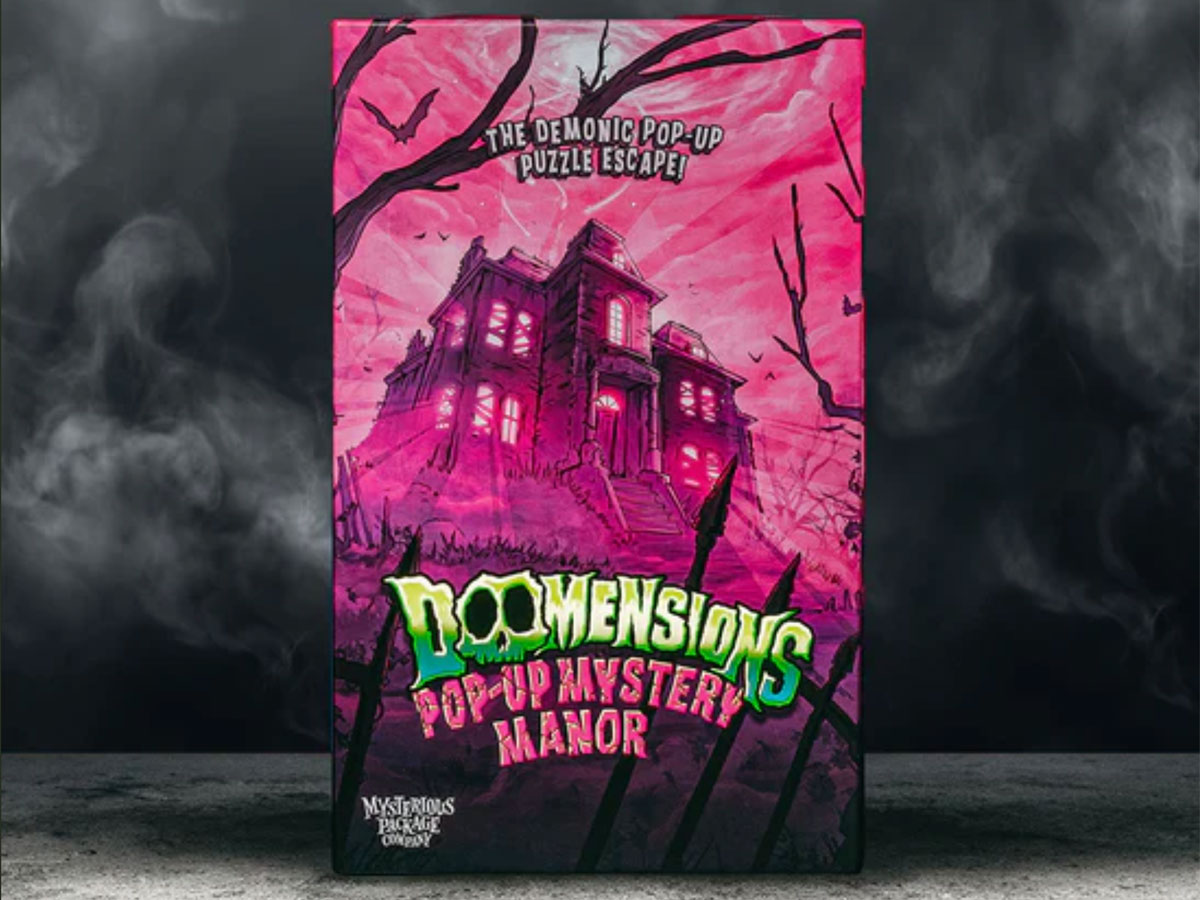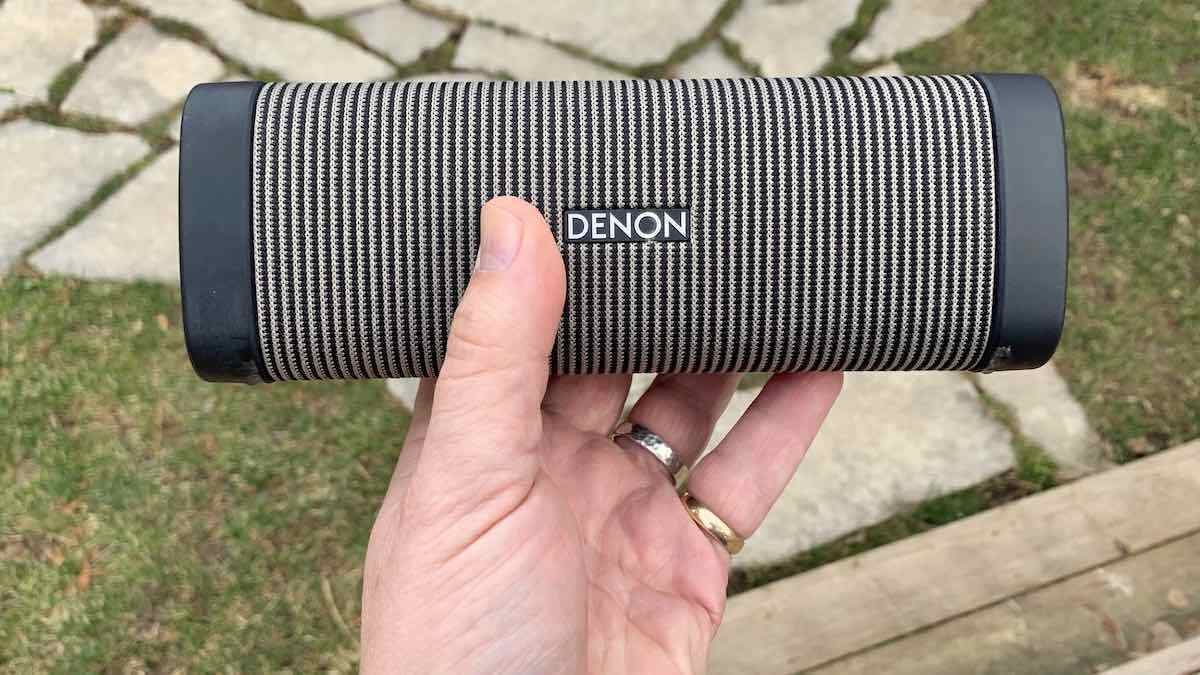Other paranormal investigators have attempted to exorcise this haunted manor but failed—will you solve the mystery?
What Is Doomensions: Pop-Up Mystery Manor?
Doomensions: Pop-Up Mystery Manor is an escape-room style game for 1 to 4 players, ages 14 and up, and takes about 8 to 12 hours over the course of 5 sessions. It retails for $87 and is available directly from the Mysterious Package Company. The theme involves a malevolent spirit that has killed (?) multiple investigators, and there are references to paranormal activity, the occult, and things like mysterious blood spatters throughout the house. So if your kid loves watching things like Ghost Hunters or horror movies then they’ll probably be fine, but if they’re easily spooked then this is probably not for them. There are 5 chapters to play, each consisting of 4 puzzles to solve. While the website gives an estimate of 8 to 12 hours, our team of (fairly experienced) puzzlers completed the whole thing in under 5 hours, so it depends a lot on your puzzle-solving abilities and/or reliance on the hint book.
Doomensions: Pop-Up Mystery Manor is published by the Mysterious Package Company.

Doomensions: Pop-Up Mystery Manor Components
Given that this is a mystery puzzle game, I can’t show you everything that’s in the box, but I’ll show you the various pieces and give you a glimpse inside while avoiding specific puzzle spoilers. Here’s what you see when you open up the box:
- Pop-up Manor
- Dossier
- Magnifying Glass
- Pencil
- Notebook
- Hint Book
- Answer Wheel
- Regifting Kit
- Cloth Bag

The biggest and primary component is, of course, the manor itself. It’s a very large pop-up book: you open it up all the way so the covers are touching, and then tie the ribbons to hold it in place. It forms a two-story house with four quadrants on each floor, and all of the furniture and the staircase pop up with it—everything is attached and there are no loose pieces, though some of the doors and cabinets can open to reveal other things inside. It’s pretty impressive and has a whole lot of fun details, though I did have one furniture piece that tended to get stuck a little and needed some help (and glue). It’s important to get the covers as tight together as possible, because the wider the book is open, the straighter everything stands.
Because of the way the house is constructed, there are often things you’ll need to look at that are on the walls or even the ceilings, and depending on where you place the house, you might have a hard time getting a good angle on it—it seems like having it raised up off the table would probably make it more comfortable without having to crouch or bend down, but sometimes we just picked it up when we really needed to inspect something closely.

The other big component is the dossier, a hardcover book made to look like a file folder, with one tab for each of the cases. The pages are covered with letters, newspaper articles, “photos,” and more. A lot of the pages fold out, and in addition to the various things that are printed on the pages, there are also a lot of items that are stuck on with glue dots or tucked into pockets: these will often be removed and used in the course of the investigations. The vast majority of these are cardstock or paper, but there are a few other fun surprises here and there. My one complaint about the inserts is that the glue dots used are really sticky—enough so that in the first chapter there were some components that I wasn’t sure we were supposed to remove from the book, and there are some components that ended up getting little surface tears from where the glue dot didn’t want to come off.

There are a few other components that aren’t as game-specific but help you with your observations and taking notes. The magnifying glass is a nice, weighty one, and is one I might just keep around for later. There’s a small spiral notebook branded to look like it’s from the fictional university, as well as a full-sized pencil also from the university. (Oddly enough, the pencil doesn’t have an eraser, which feels like a funny place to cut costs.) There’s also a small flashlight keychain—handy for helping you inspect the manor given the overhanging floors and roof, though we found our phone flashlights were often more powerful (and didn’t require holding down the button). The cloth bag is just to store all of the loose items and the hint book—it has the Doomensions logo on it and is otherwise just a nice velvety drawstring bag.

The bottom of the box has a large safe with a rotating dial, and instructions not to open until you know the combination. It’s not really locked, of course—you just pull the tab and it will open—but you should leave it alone until you get to that part of the game. As a fun bonus, the safe shows up in miniature inside the manor itself, too.
Finally, there’s the answer wheel, which you use to check your solutions. I’ll explain more about that below, but I did find it a little bit fiddly at times. There’s a “lock” slider that you use so that you don’t reveal symbols on the back as you’re turning the dials on the front, but it feels like you could just hold it in such a way that nobody is looking at the back anyway, and it would be less confusing.
The regifting kit includes copies of all of the components that get written on or otherwise altered over the course of the game so that you can reset it and give it to somebody to play one more time. If you want to use it more than that, you can also go to the Replay section of the website and print out more. The one thing that I do wish was included in the regifting kit is some glue dots. I’ve reassembled the dossier after completing the game, but many of the tools and cards are just tucked into their sections because I don’t have the glue dots anymore. I will also note that the instructions say there’s an itemized list at the back of the hint book for resetting the dossier, but there isn’t—it’s included in the downloadable file.
How to Play Doomensions: Pop-Up Mystery Manor
The Goal
The goal of the game is to solve the puzzles in each chapter: each puzzle’s solution is a 3-digit code, and solving all four will give you information about the meta-puzzle in the last chapter.

Setup
Pop open the manor and tie the ribbons, and get your writing utensils and scrap paper, and you’re all set!
Gameplay
Basically, for each chapter, you just start a timer and then open it up to that case and start reading. Each one begins with an introductory letter from Professor Musgrove—he’s the one who has recruited you—telling the story of the next ill-fated victim of the manor. Inside the file are that investigator’s notes and various tools—for instance, the spiritualist had a Ouija board and some tarot cards, among other things. In the notes, there will be four puzzles labeled with letters. You’ll need to figure out how the text leads you to a three-digit code—usually combining the various tools with the manor in some way.

When you think you’ve figured out a puzzle, use the answer wheel to check your results. The outer dial is turned to the letter of the puzzle, and then the three rings are turned to the numbers. Flip the wheel over and check the two windows on the back: if all of the icons match, then your solution is correct! (As you can see from the photo above, “000” is not the correct solution for puzzle A.) There’s a little slider along the top edge that switches from “lock” to “unlock,” and it puts a cover over both of the windows so you don’t see the icons as you’re turning the dials; however, I found that it was often tricky sliding the lock without displacing the puzzle letter, so we just stopped using it.
If you get stuck, there’s a hint book. Each puzzle has three increasingly specific hints and then gives you the solution, so if you’re ever totally stuck you can just look those up.
After solving all four puzzles, there are some additional instructions about what to do with the answers.
Game End
You can stop between each chapter, of course, but the full game ends when you’ve completed the last chapter and vanquished the evil being that has taken residence in the manor.

Why You Should Play Doomensions: Pop-Up Mystery Manor
I like playing escape room games—parsing the text to look for the actual riddle you’re trying to solve, separating clues from red herrings, and the combination of wordplay, math, observation, and leaps of logic it often takes to figure everything out. Of course, when you’re in an actual built escape room, there’s a lot more to take in: an entire environment rather than one illustration of a location, as well as the physical puzzles and gadgets to manipulate. Those are often a bit harder to incorporate in the play-at-home versions: usually, there are a few gizmos (mostly made of paper and cardboard) but the puzzles tend to lean a bit more toward the mental than the physical.
Doomensions: Pop-Up Mystery Manor brings back a little bit of that built environment. The pop-up manor is quite large and has a lot of details. Since you can’t see the whole thing at once, you’ll find yourself moving around (or moving the manor around) to get better angles at things, reproducing the feel of wandering around inside a big house looking for clues. There’s more room for red herrings, but also to spread out the clues. Since the game is actually a series of sessions, you’ll find things that clearly look important, but may be irrelevant to your current case.
One of the biggest tricks for the play-at-home games is ensuring that you have solved a riddle correctly, whether through the use of an actual physical lock or some sort of answer key. The answer wheel used here is similar to some of the other games I’ve played—it lets you check whether you have the right 3-digit code without just giving you the answer. That’s nice because if you get it wrong, you can keep puzzling it out rather than just having the answer spoiled. What we did find, however, is that if we were just off by one digit, we could tell because most of the icons matched but one didn’t—so that served as a minor spoiler.
For the most part, I enjoyed the puzzles in Doomensions: Pop-Up Mystery Manor. Almost all of them relied on information from the manor itself: finding and counting particular objects or symbols, figuring out how some tools combined with the manor, and so on. Many of the puzzles made use of the layout of the manor, too, like retracing the path an investigator took through the house.
However, there were a few times when we had figured out what the puzzle was, and we knew what information we needed to solve the puzzle, but it was frustrating when it came down to actually finding that information. One example (minor spoiler) was matching up “photographs” of certain rooms to the manor itself, and looking for differences. The problem is it was comparing an illustration of a photograph of a room to a paper pop-up model of a room, and it was not always clear which differences were intended and which were simply a result of two different media used to portray the same room. After several unsuccessful attempts at that one, we finally just resorted to using the hint book and confirmed that although we had found all the differences listed, we had also found many extras that didn’t count. Another player gave up trying to count up specific shapes throughout the manor because unless you marked them somehow, it is very difficult to keep track across eight rooms which ones you may have missed on your first pass.
I did enjoy the story behind it: the mysterious artifact and the foolhardy investigators who preceded you into the manor all have different approaches, reflected in their notes and their tools. The newspaper articles, letters, and various other documents all add a lot of flavor and help immerse you in the story, and there were a few of the puzzle mechanisms that really delighted me when I saw how they worked. I also liked the fact that it was a lengthier game overall—getting to revisit the manor several times but looking for different things each time is a nice touch, and we spread it out over several sessions so it took us a few weeks to complete it.
I’ve since reset the game using the regifting pack so I can pass it along to somebody else to try. I’ll reiterate that it would have been nice to include both the glue dots and some diagrams to show where things were originally stuck because the instructions just tell you which file each element goes but not specifically where in that file. The next group that plays my copy won’t have quite the same presentation as when I played it, but all the pieces are there at least.
If you like escape rooms and you don’t mind a bit of Where’s Waldo? hunting mixed in with your puzzles, Doomensions: Pop-Up Mystery Manor is worth a visit! Check out the Mysterious Package Company website for more information or to order a copy.
Click here to see all our tabletop game reviews.
![]() To subscribe to GeekDad’s tabletop gaming coverage, please copy this link and add it to your RSS reader.
To subscribe to GeekDad’s tabletop gaming coverage, please copy this link and add it to your RSS reader.
Disclosure: GeekDad received a copy of this game for review purposes.





